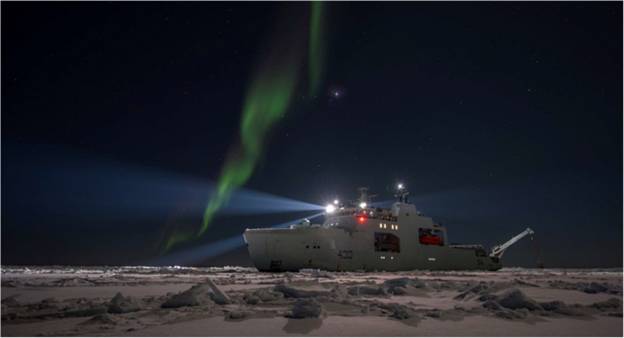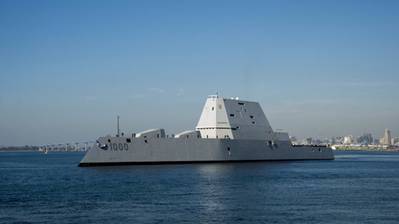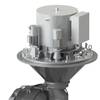Energizing Naval & Coast Guard Missions
Moises DelToro at GE Vernova’s Power Conversion business, discusses how deploying a Ship’s Electric Grid is a flexible way to accommodate growing energy demands for naval and coast guard vessels.
A new age of electrification
We’re in a new naval era and it is reshaping views about fleet mixes and capabilities. Modern fleets need to be mission-configurable, highly capable for military advantage, adaptable for technology insertion, but still affordable. The growing demand for vessel power is increasingly an enabler for mission systems, not just for platform propulsion. Adding the complexity of rapid technology change and energy transition into the mix, is why GE Vernova’s Moises DelToro advocates a collaborative approach between navies and industry to make vessels as flexible and future-proofed as possible.
DelToro has joined me to discuss the Power Conversion business’ Ship’s Electric Grid, so I start by asking why, with his naval perspective, he considers it such an important enabler. “Put simply, it’s about our ability to connect a vessel’s different power consumers with all the vessel’s available power sources. By connecting everything in a network, deploying energy that can be distributed, stored and managed, it’s way more flexible, and way more scalable, from support vessels to complex surface combatants. You’re not restricted by assigning power only to propulsion or only to ship’s services.”
GE Vernova’s Power Conversion
With a heritage of 120 years of electrification in the US by GE Vernova’s ultimate founder, Thomas Edison, the Power Conversion business has been innovating naval, full-electric power and propulsion systems for decades. DelToro comments: “When I joined Power Conversion after leaving the navy, I was impressed by the technology and systems integration capability. As a defense systems guy, I knew that systems integration is super important, and it comes through proving integrated systems at sea.” Referencing the 130 electric naval references with 15 navies, DelToro continues: ”That credibility really counts for everything in the naval domain. I also like the practical mindset in the business that comes from working in the commercial marine segment, but it’s the expertise in naval-specification performance that struck me most when I arrived at Power Conversion.”
Trends in vessel power and energy
Looking at the trends in naval power and energy requirements also tells us what is driving technology development. There are four areas to highlight here. First, with the demands for electric power increasing, the need for space-saving systems is important, or as Moises notes, “We can’t just throw more power on smaller vessels. Our technologies like compact systems, permanent magnet (PM) motors and podded propulsion can all contribute to space-saving.” Second is a parallel shift to higher voltages, including to accommodate a new generation of energy-intensive defense systems.
A third imperative is about new, more energy-efficient architectures. And for navies and coast guards, this energy and fuel-efficiency has two benefits: the potential to stay ‘on-mission’ for longer as well as sustainability to support a reduction in emissions.
In fact, as GE Vernova is seeing in commercial marine applications, electric ships’ power networks provide a common, high-quality front end to integrating different energy sources, currently energy storage and fuel cells. This integration enabler is important to consider as we think ahead to those energy devices which may emerge over the next decades. DelToro comments: “’Plugging-in’ is over-simplifying it! But the ship’s electric power network can help us both ‘plug-in’ energy sources at one end and connect new mission modules at the other end.”
Finally, fourth, is how the Ship’s Electric Grid is inherently able to host control, higher levels of automation, and system-of-systems communication. This opens up opportunities to integrate machine-learning, data and a shift towards autonomy. As DelToro points out: “That can mean autonomous vessels, but it can also be more-autonomous systems on manned vessels.”
Among the many classes of naval vessel it has supplied, Power Conversion is the designer and provider of the high-voltage system propulsion drive trains for the US Navy’s DDG 1000 Zumwalt class of destroyers, including multi-phase converters and powerful naval electric propulsion motors. It’s the US Navy’s most advanced multi-mission destroyer, and its first, full electric propulsion ship. Balancing proven capability with future-capable technologies, the navy engaged with industry to help meet its demanding needs. Designed for surface warfare, anti-aircraft and naval fire support, the ship’s revolutionary technologies extend from its outward appearance to its on-board equipment.
Employing Power Conversion’s innovative Integrated Power System (IPS), the DDG 1000 has the capacity to distribute electricity across the entire ship, allowing for enhanced power flexibility for various operational requirements. Both the shock-rated drive trains have two electric motors in tandem. Compact, efficient power electronic, variable speed drives with three independent channels accompany the 15-phase motors. Each motor drive train can operate on 5, 10 or 15 phases. This provides high redundancy and is more economical when running at lower power.
I raise the topic of technology-proving with Moises, and the expertise needed: “I come back to this deep know-how in naval requirements because it’s what allows us to manage and prove electrical performance and resilience, mechanical strength, robustness, and reduced maintenance together. That capability includes a team that is experienced in working a program closely with the Naval Surface Warfare Centre (NSWC) land-based engineering site and is backed by its own full-scale and full-load Marine Power Test Facility. We work to a navy’s specific needs, but benefit from decades of valuable learning – and de risking – from other programs.”
With 72MW of electric propulsion power, the Power Conversion business’ Integrated Full Electric Propulsion (IFEP) system eliminates the need for the drive shaft and reduction gears and brings benefits in acoustic signature reduction, and an increase in available power for operational requirements. The all-electric propulsion also generates additional reserved power, allowing the integration of future high-energy defense systems and sensors.
Scalable to smaller vessels
Although the business’ solutions extend to aircraft carrier-scale - 110MW Ship’s Electric Grid on the UK Royal Navy’s Queen Elizabeth Class - DelToro notes increased customer demand for smaller vessel solutions too, from coast guard patrol to naval reconnaissance missions. “The ship’s electric grid is hugely versatile, and electric drive ships are just as suited to smaller, lower voltage, more commercial-spec, multi-role vessels needing sustainable, energy-efficient performance for patrol duties. If it’s viable in the commercial sector it is for government vessels too.” Harry DeWolf-class offshore patrol vessel. image credit, Royal Canadian Navy
Harry DeWolf-class offshore patrol vessel. image credit, Royal Canadian Navy
An example is the Royal Canadian Navy’s Arctic Offshore Patrol Ships (AOPS), its first full-electric power and propulsion, ice-class patrol vessels with a combat package. Power Conversion is the designer and provider of the high-voltage electric power system (HV) and electric propulsion drive trains, with specialist capability for operations in multi-year ice. The 9MW system is ideally suited to long range operations above the Arctic Circle, including an ability to deliver high intermittent over-torque at zero and low RPM should the propellers encounter heavy ice loads.
Power Conversion also provides power and propulsion for the National Security Multi-Mission Vessels (NSMVs) for the US Department of Transportation’s Maritime Administration (MARAD). The new ships have an all-electric plant, enabling students to be trained on some of the latest technology being used in the commercial marine industry.
Technology and innovation focus
We wrap our discussion with insights into other technologies and applications, both for future fleets and fleet mission system updates. Electro-magnetic (EM) aircraft launch technology and the associated electrical systems are rapidly developing and being considered for a broader set of future naval platforms beyond typical, full-scale manned airframes. Recent advancements are particularly interesting for naval unmanned aerial vehicle (UAV) applications. Power Conversion has completed several de-risking demonstrators of the core EMKIT (electro-magnetic kinetic integrated technology) and EMCAT (electro-magnetic catapult) technologies, using simulation, and full-scale and land-based testing facilities.
DelToro adds, “In terms of power density there is potential for some really game-changing solutions, but that’s a conversation for another day!”
As we conclude, I run through my takeaways with Moises: availability, configurability and scalability of electric power and energy are critical enablers of operations, just like in the commercial world. They unlock military effects, speed, responsiveness, endurance and connectivity. There is a growing recognition that electrification is critical to new generations of networked mission systems and the right architecture to ‘plug in’ new energy sources. Through electrification, smart automation and control, energy harnessed in the Ship’s Electric Grid is ready to supply high-energy defense systems and integrate cleaner, more efficient future energy technologies.
GE Vernova’s Rachel Connor was in conversation with Moises DelToro III, Rear Admiral, USN (Ret). DelToro is VP Marine Business Development, North America, at GE Vernova’s Power Conversion business.












